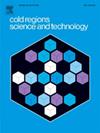An artificial neural network correlation for the wave-induced melt rate of floating icebergs in the Barents Sea
IF 3.8
2区 工程技术
Q1 ENGINEERING, CIVIL
引用次数: 0
Abstract
Iceberg deterioration models are commonly coupled to iceberg drift models in the literature to improve the accuracy of predicting iceberg drift trajectories when exposed to open water. Wave-induced erosion is the major mechanism of iceberg deterioration, typically estimated by simple parametrized equations in the literature. Using linear wave theory, this paper develops a novel model to determine the wave-induced melt rate on the submerged lateral surface of a floating cylindrical iceberg with two degrees of freedom, including surge and heave motions. Existing solutions to the boundary value problems due to wave diffraction and radiation are adopted in this study to yield the water particle and iceberg velocities and, subsequently, the wave convective coefficient. A parametric study is conducted to investigate the sensitivity of the modeled melt rate to input parameters, including wave period, wave height, iceberg radius, iceberg width to height ratio, circumferential angle, and the vertical position on the iceberg draft. This model for the melting rate is then used to produce a dataset within the range of input parameters. The main novelty of this paper is to use this dataset to train an Artificial Neural Network (ANN) model and present a new correlation for the wave-induced melt rate. This correlation, which is easier to implement than the original analytical solution, is a function of iceberg radius, iceberg height, wave period, and wave height. Results indicate a peak in the wave-induced melt rate diagrams along with the wave period for different values of input parameters. This peak occurs at a wave period close to the iceberg's natural heave period because the iceberg in this condition undergoes a significant movement in the vertical direction due to heave resonance. The Reynolds number is found to be the key parameter on model generalization. In addition, predicted melt rates by the ANN correlation agree well with model results.
巴伦支海浮冰受波浪影响融化速率的人工神经网络关联
在文献中,冰山恶化模型通常与冰山漂移模型相结合,以提高冰山暴露在开阔水域时漂移轨迹的预测精度。波浪侵蚀是冰山退化的主要机制,在文献中通常用简单的参数化方程来估计。本文利用线性波浪理论,建立了一种新的模型,用于确定具有激波运动和升沉运动的两自由度圆柱形浮动冰山被淹没侧表面的波浪诱导融化速率。本研究采用现有的波衍射和辐射边值问题解,得到水粒子速度和冰山速度,进而得到波浪对流系数。通过参数化研究,探讨了模型融化速率对波周期、波高、冰山半径、冰山宽高比、周向角和冰山吃水垂直位置等输入参数的敏感性。然后使用该熔化速率模型在输入参数范围内生成数据集。本文的主要新颖之处在于使用该数据集训练人工神经网络(ANN)模型,并给出了波致融化速率的新相关性。这种相关性比原来的解析解更容易实现,它是冰山半径、冰山高度、波浪周期和波浪高度的函数。结果表明,在不同的输入参数值下,熔体速率随波动周期的变化出现峰值。这个峰值发生在接近冰山自然隆起周期的波浪周期,因为在这种情况下,由于隆起共振,冰山在垂直方向上经历了显著的运动。发现雷诺数是模型泛化的关键参数。此外,人工神经网络预测的熔体速率与模型结果吻合较好。
本文章由计算机程序翻译,如有差异,请以英文原文为准。
求助全文
约1分钟内获得全文
求助全文
来源期刊

Cold Regions Science and Technology
工程技术-地球科学综合
CiteScore
7.40
自引率
12.20%
发文量
209
审稿时长
4.9 months
期刊介绍:
Cold Regions Science and Technology is an international journal dealing with the science and technical problems of cold environments in both the polar regions and more temperate locations. It includes fundamental aspects of cryospheric sciences which have applications for cold regions problems as well as engineering topics which relate to the cryosphere.
Emphasis is given to applied science with broad coverage of the physical and mechanical aspects of ice (including glaciers and sea ice), snow and snow avalanches, ice-water systems, ice-bonded soils and permafrost.
Relevant aspects of Earth science, materials science, offshore and river ice engineering are also of primary interest. These include icing of ships and structures as well as trafficability in cold environments. Technological advances for cold regions in research, development, and engineering practice are relevant to the journal. Theoretical papers must include a detailed discussion of the potential application of the theory to address cold regions problems. The journal serves a wide range of specialists, providing a medium for interdisciplinary communication and a convenient source of reference.
 求助内容:
求助内容: 应助结果提醒方式:
应助结果提醒方式:


